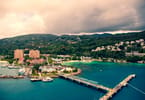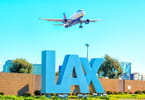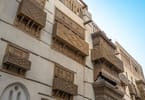The National Park Service and the US Department of the Interior describe the history of the Willard Hotel as follows:
American author Nathaniel Hawthorne observed in the 1860s that “the Willard Hotel more justly could be called the center of Washington than either the Capitol or the White House or the State Department.” From 1847 when the enterprising Willard brothers, Henry and Edwin, first set up as innkeepers on the corner of 14th Street and Pennsylvania Avenue, the Willard has occupied a unique niche in the history of Washington and the nation. In 1847, Benjamin Ogle Tayloe leased the establishment to Henry A. Willard and his brother, Edwin. In 1858, the Willards expanded again, purchasing the property of Col. James Kearney and built a six-story addition to the hotel…
At the beginning of the twentieth century, a new Willard Hotel was built by the George A. Fuller Company to the designs of the famous architect Henry Janeway Hardenbergh. In 1922, a major fire caused the evacuation by Vice President Calvin Coolidge, several US Senators, composer John Philip Sousa, movie producer Adolph Zukor and other attendees at the annual Gridiron Dinner.
Presidents Taylor, Fillmore, Pierce, Buchanan, Lincoln, Grant, Taft, Wilson, Coolidge and Harding stayed at the Willard. Other notable guests have included Charles Dickens, Buffalo Bill, David Lloyd George, P.T. Barnum, and countless others. Walt Whitman included the Willard in his verses and Mark Twain wrote two books there in the early 1900s. It was Vice President Thomas R. Marshall, annoyed at the Willard’s high prices, who coined the phrase “What this country needs is a good 5-cent cigar.”
Situated just two blocks from the White House, the hotel is replete with the ghosts of the famous and powerful. Over the years it has been the gathering place for presidents, politicians, governors, literary and cultural figures. It was at the Willard that Julia Ward Howe composed “The Battle Hymn of the Republic.” Gen. Ulysses S. Grant held court in the lobby and Abraham Lincoln borrowed house slippers from its proprietor. Mark Twain, Charles Dickens, Nathaniel Hawthorne and Jenny Lind were all part of the parade of celebrated Willard guests.
Even the uniquely political term “lobbyist” is said to have been coined at the Willard to describe those 19thcentury special-interest promoters who cornered politicians in the opulent Willard lobby.
The Willard sat vacant and in danger of demolition from 1968 until 1986 when it was restored to its former glory. A $73 million restoration project was carefully planned by the National Park Service to recreate the hotel as historically accurate as possible. Sixteen layers of paint were scraped from the woodwork to ascertain the hotel’s original 1901 colors.
New York Times Architekturkritiker Paul Goldberger huet den 22. September 1986 geschriwwen:
Most restorations of venerable buildings fall into one of two categories; They are either attempts to recreate as faithfully as possible what once was, or they are inventive interpretations that use the original architecture as a jumping-off point.
Déi nei rehabilitéiert Willard Hotel ass souwuel. D'Halschent vun dësem Projet implizéiert déi respektvoll Restauratioun vum gréisste Hotelgebai vu Washington, eng ausgezeechent Beaux-Arts Struktur vum Henry Hardenbergh, déi zanter 1968 ofgerappt gouf, en Affer vum Ënnergang vu senger Noperschaft, e puer Block ëstlech vum Wäissen Haus. Déi aner Halschent ass eng exuberant konzipéiert, fuschneie Ergänzung mat Büroen, Geschäfter, ëffentlech Plaz an en neie Ballsall fir den Hotel.
The hotel’s grand reopening in 1986 under the management of the InterContinental hotel chain – its full name is the Willard InterContinental Washington – was credited with rejuvenating downtown Washington.
The Willard InterContinental Washington is a member of Historic Hotels of America and the National Trust for Historic Preservation.
Dësen Artikel gouf mat der Erlaabnis vum Auteur aus dem Buch erausgeholl, "Built To Last: 100+ Year-Old Hotels East of the Mississippi," AuthorHouse 2013. Den Auteur, Stanley Turkel, ass eng unerkannt Autoritéit a Beroder an der Hotelindustrie. Hien bedreift säin Hotel, Gaaschtfrëndlechkeet a Consultatioun Praxis spezialiséiert am Asset Management, operationell Auditen an der Efficacitéit vun Hotel Franchising Accorden a Prozess Ënnerstëtzung Aufgaben. Clientë sinn Hotelbesëtzer, Investisseuren a Prêtinstituter. Säi lescht Buch ass "Hotel Mavens: Lucius M. Boomer, George C. Boldt and Oscar of the Waldorf."
WAT VUN DESEN ARTIKEL WEI HUELEN:
- From 1847 when the enterprising Willard brothers, Henry and Edwin, first set up as innkeepers on the corner of 14th Street and Pennsylvania Avenue, the Willard has occupied a unique niche in the history of Washington and the nation.
- Half of this project involves the respectful restoration of Washington’s greatest hotel building, a distinguished Beaux-Arts structure by Henry Hardenbergh that had been derelict since 1968, a victim of the decline of its neighborhood, a few blocks east of the White House.
- Den amerikaneschen Auteur Nathaniel Hawthorne huet an den 1860er observéiert datt "de Willard Hotel méi gerecht den Zentrum vu Washington genannt ka ginn wéi entweder d'Kapitol oder d'Wäiss Haus oder de Staatsdepartement.






















